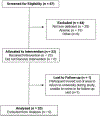A Food-Derived Dietary Supplement Containing a Low Dose of Iron Improved Markers of Iron Status Among Nonanemic Iron-Deficient Women
- PMID: 29533710
- PMCID: PMC6089218
- DOI: 10.1080/07315724.2018.1427158
A Food-Derived Dietary Supplement Containing a Low Dose of Iron Improved Markers of Iron Status Among Nonanemic Iron-Deficient Women
Abstract
Objective: Iron deficiency is the most common nutrient deficiency in the world. While deficiency can often be resolved through dietary supplementation with iron, adverse events are common and frequently preclude compliance. The objective of this study was to determine whether a food-derived dietary supplement containing a low dose of iron and nutrients that increase iron absorption could resolve iron deficiency with fewer adverse events than reported at higher doses.
Methods: A pilot clinical trial (NCT02683369) was conducted among premenopausal women with nonanemic iron deficiency that was verified by blood screening. Participants consumed a dietary supplement (Blood Builder®/Iron Response®) once daily for 8 weeks containing 26 mg of iron, vitamin C, folate, and other food-derived nutrients. Primary outcomes were markers of iron status (serum ferritin, hemoglobin, soluble transferrin receptor, total body iron stores) and secondary outcomes were self-reported fatigue and energy. All outcomes were assessed at baseline and 8 weeks. Adverse events were monitored with questionnaires, daily diaries, and contact with a physician. Dependent samples t test and Wilcoxon signed-rank test were used to analyze outcomes.
Results: Twenty-three participants enrolled in the study. Iron deficiency was resolved in the sample (mean serum ferritin: baseline = 13.9 μg/L, 8 weeks = 21.1 μg/L, p < 0.001). All other markers of iron status, fatigue, and energy also improved during the study (p < 0.04). No adverse events were reported.
Conclusions: While larger and controlled studies are needed to confirm these findings, a food-derived dietary supplement with a low dose of iron and absorption-enhancing nutrients resolved iron deficiency and improved all other markers of iron status without any adverse events.
Keywords: Iron; dietary supplement; ferritin; folate; hemoglobin; nonanemic iron deficiency; soluble transferrin receptor; total body iron stores; vitamin C.
Similar articles
-
Dietary and supplement treatment of iron deficiency results in improvements in general health and fatigue in Australian women of childbearing age.J Am Coll Nutr. 2001 Aug;20(4):337-42. doi: 10.1080/07315724.2001.10719054. J Am Coll Nutr. 2001. PMID: 11506061 Clinical Trial.
-
Iron prophylaxis during pregnancy -- how much iron is needed? A randomized dose- response study of 20-80 mg ferrous iron daily in pregnant women.Acta Obstet Gynecol Scand. 2005 Mar;84(3):238-47. doi: 10.1111/j.0001-6349.2005.00610.x. Acta Obstet Gynecol Scand. 2005. PMID: 15715531 Clinical Trial.
-
Home fortification of foods with multiple micronutrient powders for health and nutrition in children under two years of age (Review).Evid Based Child Health. 2013 Jan;8(1):112-201. doi: 10.1002/ebch.1895. Evid Based Child Health. 2013. PMID: 23878126 Review.
-
Efficacy of iron supplementation may be misinterpreted using conventional measures of iron status in iron-depleted, nonanemic women undergoing aerobic exercise training.Am J Clin Nutr. 2017 Dec;106(6):1529-1538. doi: 10.3945/ajcn.117.152777. Epub 2017 Nov 1. Am J Clin Nutr. 2017. PMID: 29092885 Clinical Trial.
-
Iron deficiency: assessment during pregnancy and its importance in pregnant adolescents.Am J Clin Nutr. 1994 Feb;59(2 Suppl):502S-508S discussion 508S-510S. doi: 10.1093/ajcn/59.2.502S. Am J Clin Nutr. 1994. PMID: 8304288 Review.
Cited by
-
Correlates of Nonanemic Iron Deficiency in Restless Legs Syndrome.Front Neurol. 2020 Apr 30;11:298. doi: 10.3389/fneur.2020.00298. eCollection 2020. Front Neurol. 2020. PMID: 32425874 Free PMC article.
-
Circulating microRNAs and hepcidin as predictors of iron homeostasis and anemia among school children: a biochemical and cross-sectional survey analysis.Eur J Med Res. 2023 Dec 15;28(1):595. doi: 10.1186/s40001-023-01579-5. Eur J Med Res. 2023. PMID: 38102707 Free PMC article.
References
-
- Huebers H Iron metabolism: iron transport and cellular uptake mechanisms In: Lonnerdal B, editor. Iron metabolism in infants. Boca Raton (FL): CRC Press; 1989. p. 163.
-
- Anderson G, Vulpe C. The cellular physiology of iron In: Yehuda S, Mostofsky DI editors. Iron deficiency and overload: from basic biology to clinical medicine. Totowa, NJ: Humana Press; 2010. p. 3–29.
Publication types
MeSH terms
Substances
Associated data
Grants and funding
LinkOut - more resources
Full Text Sources
Other Literature Sources
Medical

